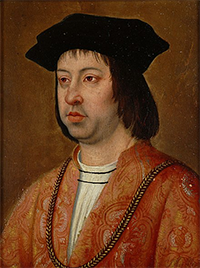Medieval Spain's Royal Couple: Ferdinand and Isabella
Part 2: Worldwide Fame The last decade of the 15th Century was a momentous year for Spain. In early 1492, Christian armies succeeded in conquering Granada, the last surviving part of the Iberian Peninsula ruled by the Moors. This completed the Reconquista, an effort by armies from all Christian powers on the Iberian Peninsula to assert their authority over their ancestral homeland. Later that year, the Italian explorer Christopher Columbus sailed on behalf of Ferdinand and Isabella to the New World, bring back word of new lands and new civilizations and the promise of plenty of wealth and power across the Atlantic Ocean.  Two years later, the joint rulers signed an agreement with King John II of Portugal to divide ownership rights of New World territory between the countries. This was the Treaty of Tordesillas, agreed to on June 7, 1494. This was, in fact, a pronouncement by Pope Alexander VI that drew a north-south line on the map and divided North America and South America between Spain and Portugal. In reality, most of the New World was west of the line and so Spain ended up getting nominal authority over much more territory than Portugal did. During the next few years, Spain added a number of territories to its holdings, completing the possession of the Canary Islands and establishing several colonies in north Africa. It was also in 1492 that the monarchs, devout Catholics both, announced the Alhambra Decree, which required anyone practicing the Jewish faith to convert to Catholicism or to leave Spain entirely. The issuing date of the decree was March 31; Jews living in Spain had four months to leave, and they were forbidden from taking any horses, weapons, gold, silver, or money of any kind with them. Sources estimate that the number of Jews who left Spain at this time to be in the tens of thousands. A decade later came a similar decree for Muslims living in Granada; a great many converted to Christianity rather than leave their homes. In a related vein was the Spanish Inquisition. Ferdinand and Isabella had established in the late 1470s a blueprint for seeking out and identifying and/or punishing people living in Aragon, Castile, and all other Spanish territories who did not profess the Catholic faith. Early targets were Jews and Muslims who had professed a conversion to Christianity rather than leaving the country. Inquisition officials were suspicious of the sincerity of such conversions. (As it turned out, such suspicions were well founded because a great many former Jews and Muslims kept their original faith in secret while publicly expressing a preference for Catholicism.) As well, Inquisition officials targeted people who had made public statements that were in opposition to teachings of the Catholic Church. The Inquisition carried on long after both Ferdinand and Isabella were gone. 
Ferdinand got involved in land disputes involving France and Italy. He joined with a consortium of Italian princes and Holy Roman Emperor Maximilian I to put the throne of Naples back in Italian hands, after France's Charles VIII invaded and claimed it in 1494. Ferdinand expanded his reach in 1501, gaining Apulia and Calabria as a result of an alliance with the next French king, Louis XII, who claimed Naples. As so often happened, the agreement turned acrimonious and Spanish troops fought French troops for control of Naples. Ferdinand's forces won, in 1504. Isabella died in that year, on October 12. She left as her successor her daughter Joanna. Ferdinand stepped down as ruler of Castile but retained some leadership role as governor. He and Joanna's husband, Archduke Philip, agreed to tolerate each other. Ferdinand favored France again in 1505, marrying Germaine of Foix to seal the deal. He returned to a leadership role in Castile the following year, after his son-in-law, Philip, died suddenly and Joanna proved unfit to rule. Ferdinand was again at war in Italy in 1508, as part of the League of Cambrai, an anti-Venice consortium that included France, the Holy Roman Empire, and the pope. That group of powers defeated Venice, but Ferdinand and the pope then joined together to oppose France. To keep the alliance with England, Ferdinand and Isabella agreed to marry the widowed Catherine to Arthur's younger brother, who became King Henry VIII. Henry and Catherine were married on June 11, 1509; thus, 13 days later, when Henry was crowned king, Catherine was crowned queen. Two years later, Ferdinand and Henry signed the Treaty of Westminster, an agreement for joint aid against common enemies, in this case France and Navarre, the Basque kingdom in the north of the Iberian Peninsula. Ferdinand conquered Navarre in 1512. Also at this time, Ferdinand and his advisers finally came to a decision as to how to treat indigenous Americans that Columbus and other explorers found in their explorations in the New World. Columbus had brought back a handful of indigenous people, in chains, and presented them to Ferdinand and Isabella as a present. The horrified monarchs had ordered the chains taken off and the "visitors" free to go, although Isabella, especially, encouraged them to embrace Christianity. In 1512–1513, Ferdinand issued the Laws of Burgos, which prohibited the enslavement of indigenous Americans but, at the same time, treated them poorly in other ways, including forcing many of them to leave their homes and live in Encomiendas, grouped together in estates along the lines of a feudal fiefdom. These were, of course, in the New World, initially in Hispaniola but also Jamaica and Puerto Rico. Ferdinand died on Jan. 23, 1516, in Madrigalejo, Extremadura, in Castile. His daughter Joanna became Queen of Aragon, and her son Charles was named regent. First page > Setting the Stage > Page 1, 2 |
|
Social Studies for Kids
copyright 2002–2026
David White




